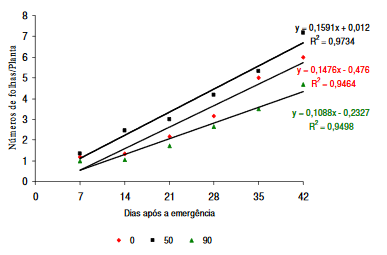Initial growth of plants of physic nut under shading in the Gurupi county, Tocantins State, Brazil
DOI:
https://doi.org/10.20873/jbb.uft.cemaf.v2n4.costaKeywords:
Jatropha curcas, análise de crescimento, luminosidade, EuphorbiaceaeAbstract
The growth analysis has been used by researchers to explain differences in the growth, which can be caused for genetic factors or by environmental modifications and constitutes efficient tool for the identification of favorable environments, besides identifying characteristics in the initial growth, to indicate possibility in the increase of growth of the adult plant, favoring the genetic breeding for material more productive. The aim of this research was to study the initial growth of the physic nut (Jatropha curcas L.) in three shading levels (0%, 50% and 90%). The evaluated variables were height of plants, stem base diameter, leaf area, dry mass of the leaves, total dry mass and number of leaves at the 7, 14, 21, 28, 35 and 42 days after the emergency of the plants. The largest height of the plants was observed in 50% of shading and the smallest in 0% of shading. The largest stem base diameter was obtained in plants with 0% of shading and the smallest in 90%. Plants cultivated on 50% of shading presented larger number of leaves, leaf area, dry mass of the leaves and total dry mass. The best development of seedlings of physic nut occurs under 50% of shading in the Gurupi, TO.
References
Arruda, F. P.; Beltrão, N. E. M.; Andrade, A. P.; Pereira, W. E.; Severino, L. S. (2004), Cultivo de pinhão manso (Jatropha curcas L.) como alternativa para o semi-árido nordestino. Revista Brasileira de Oleaginosas e Fibrosas, Campina Grande, 8, 789-799.
Atroch, E. M. A. C.; Soares, A. M.; Alvarenga, A. A.; Castro, E. M. (2001), Crescimento, teor de clorofilas, distribuição de biomassa e características anatômicas de plantas jovens de Bauhinia forticata LINK submetidas à diferentes condições de sombreamento. Ciência e Agrotecnologia, 25, 853-862.
Benincasa, M. M. P. (1988), Análise de crescimento de plantas (noções básicas). Jaboticabal: FCAV-UNESP. 42 p.
Costa, J. L.; Silva, A. L. L.; Scheidt, G. N.; Lemus, E. A. E.; Soccol, C. R. (2010), Estabelecimento in vitro de sementes de pinhão manso (Jatropha curcas L.) - Euphorbiaceae. Caderno de Pesquisa Série Biologia, 22, 5-12.
Farias, V. C. C.; Costa, S. S.; Batalha, L. F. P. (1997), Análise de crescimento de mudas de cedrorana (Cedrelinga catenaeformis (Ducke) Ducke) cultivadas em condições de viveiro. Revista Brasileira de Sementes, Brasília, 2, 193- 200.
Felfili, J. M. (1999), Comportamento de plântulas de Sclerolobium paniculatum Vog. var. rubiginosum (Tul.) Benth. sob diferentes níveis de sombreamento, em viveiro. Revista Brasileira de Botânica, 2, 297-301. Suplemento.
Kitao, M.; Lei, T. T.; Koike, T.; Tobita, H.; Maruyama, Y. (2000), Susceptibility to photoinhibition of three deciduous broadleaf tree species with different successional traits raised under various light regimes. Plant, Cell and Environment, 23, 81-89.
Mazzei, L. J.; Felfili, J.M.; Rezende, A.V.; Franco, A.C.; Sousa-Silva, J.C.; (1998), Crescimento de plântulas de Schefflera morototoni (Aubl.) Maguire, Steyermark e Frodin em diferentes níveis de sombreamento no viveiro. Boletim do Herbário Ezechias Paulo Heringer, Brasília, 3, 27-36.
Mazzei, L. J.; Sousa-Silva, J.C.; Felfili, J.M.; Rezende, A.V.; Franco, A.C.; (1999), Crescimento de plântulas de Hymenaea coubaril L. var. stilbocarpa (Hayne) Lee e Lang. em viveiro. Boletim do Herbário Ezechias Paulo Heringer, Brasília, 4, 21-29.
Pereira, J. C. S.; Fidelis, R. R.; Erasmo, E. A. L.; Santos, P. M.; Barros, H. B.; Carvalho, G. L. (2011), Florescimento e frutificação de genótipos de pinhão manso sob doses de fósforo no cerrado da Região Sul do Tocantins. Journal of Biotechnology and Biodiversity, 2, 28-36.
Santos, P. M.; Fidelis, R. R.; Pereira, J. C. S.; Erasmo, E. A. L.; Barros, H. B.; Carvalho, G. L. (2011), Formas e épocas de amostragem em folhas de pinhão manso para quantificação da área foliar. Journal of Biotechnology and Biodiversity, 2, 51- 57.
Saturnino, H. M.; Pacheco, D. D. ; Kakida , J. ; Tominaga, N.; Gonçalves , N. P. (2005), Cultura do pinhão–manso (Jatropha curcas L.). Informe agropecuário, Belo Horizonte, 229, 44–78.
Severino, L. V.; Vale, L.S.; Beltrão, N.E. (2007), A simple method for measurement of Jatropha curcas leaf area. Revista Brasileira de Oleaginosas e Fibrosas, Campina Grande, 1, 9-14.
Silva, R. R.; Freitas, G. A.; Siebeneichler, S. C.; Mata, J. F.; Chagas, J. R. (2006), Desenvolvimento inicial de plântulas de Theobroma grandiflorum (Willd. ex Spreng.) Schum. sob influência de sombreamento. Acta Amazônica, 3, 365-370.

Published
How to Cite
Issue
Section
License
Copyright (c) 2024 - Journal of Biotechnology and Biodiversity

This work is licensed under a Creative Commons Attribution 4.0 International License.
Authors who publish with this journal agree to the following terms:
Authors retain copyright and grant the journal right of first publication with the work simultaneously licensed under a Creative Commons Attribution License (CC BY 4.0 at http://creativecommons.org/licenses/by/4.0/) that allows others to share the work with an acknowledgement of the work's authorship and initial publication in this journal.
Authors are able to enter into separate, additional contractual arrangements for the non-exclusive distribution of the journal's published version of the work (e.g., post it to an institutional repository or publish it in a book), with an acknowledgement of its initial publication in this journal.
Authors are permitted and encouraged to post their work online (e.g. in institutional repositories or on their website) prior to and during the submission process, as it can lead to productive exchanges, as well as earlier and greater citation of published work (Available at The Effect of Open Access, at http://opcit.eprints.org/oacitation-biblio.html).


